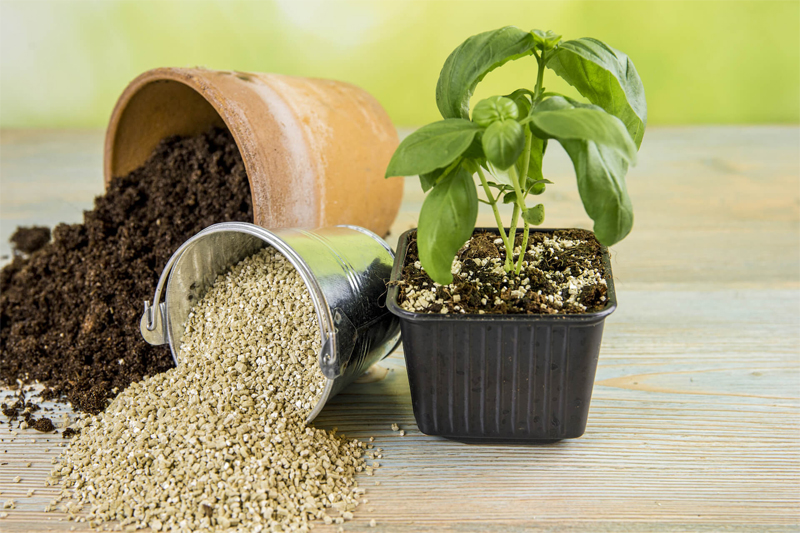If you find that your garden soil is lacking in any or all of these areas, there is If you find that your garden soil is lacking in any or all of these areas, there is something you can add to improve the soil structure - vermiculite. What is vermiculite and how can I use it as a beneficial growing medium for my soil?
Vermiculite can be found in potting soil or can be purchased separately in four different sizes for gardening. Use the smallest size vermiculite as a growing medium and the largest size vermiculite for germination to improve soil aeration.
Vermiculite is the name given to a group of hydrated layered minerals (aluminum-iron-magnesium silicates) that look like mica. vermiculite is heavily heated to expand it into accordion-like particles consisting of multiple layers of thin plates. It will not rot, spoil or mold and is durable, odorless, non-toxic and sterile.
Vermiculite is usually neutral to 7.0 pH, but depending on the source from the globe, its reaction is alkaline.
It is very light and mixes easily with other media.

Vermiculite added to garden or potting soil can increase water and nutrient retention and aerate the soil, resulting in healthier, more robust plants. Perlite may also be present in potting soil, but vermiculite retains water much better. Although not as aerated as perlite, vermiculite is a preferred amendment for water-loving plants. The following are other uses of vermiculite.
► Vermiculite mixed with soil, peat or compost eliminates soil build-up in pots and houseplant containers while allowing good aeration, reducing watering frequency and allowing root spread.
► Add vermiculite to the soil alone or with peat or compost for conditioning and mitigation. This will accelerate the growth of young roots and promote anchoring.
►Using vermiculite as a growing medium will also make it easier for plants to absorb the ammonium, potassium, calcium and magnesium needed for vigorous growth.
► Intermediate vermiculite can be used directly in root cuttings. Simply water thoroughly and insert the cutting into the node.
►Use vermiculite alone or mixed with soil or peat for seed germination. This will allow the seeds to germinate faster. If using vermiculite without soil, feed the seedlings a weak fertilizer solution of 1 tablespoon (15 ml) of soluble fertilizer per 1 gallon (4 liters) of water as soon as the first leaves appear. Damping off is impeded because the vermiculite is sterile and the seedlings can be easily removed without damaging the roots.
►To use vermiculite for transplanting, dig a hole 6 inches (15 cm) larger than the plant roots. Fill with a mixture of vermiculite and removed topsoil. Again, this allows the roots to spread, provides moisture control, and prevents the roots from drying out due to sun or wind. 3 inches (8 cm) of vermiculite can also be used as mulch around shrubs and other garden plants such as roses, dahlias, and tomatoes.
► Place bulbs or tuber crops in a container and pour vermiculite around them. The spongy quality of the vermiculite will absorb any excess moisture and prevent decay or mildew, while protecting them from temperature changes.
► Even newly seeded lawns can benefit from the application of vermiculite. Mix 3 cubic feet (0.08 cubic meters) of vermiculite per 100 square feet (9 square meters), seed, and then cover the entire area with 1/4 inch (6 mm) of vermiculite. Water with a fine spray. The vermiculite will speed germination and increase the number of seeds that germinate while retaining moisture and preventing drying and heat exposure.
► Finally, vermiculite can be used in flower arrangements. Fill the container with vermiculite, soak it thoroughly with water, pour off the excess, and then sort the flowers. This eliminates the need for water changes, eliminates spillage, and keeps the flowers fresh for several days. Be sure to use horticultural vermiculite, not the vermiculite sold for house insulation - it's treated for water resistance!
Copyright © Hebei Jufuyuan Trading Co., Ltd. All Rights Reserved | Sitemap
E-mail: info@jufuyuan-s.com
Mobile: +86 137 3119 7671
Skype: seansu9
WhatsApp: +86 137 3119 7671
QQ: 369706292
Add: 2-2-707 Caifutianxia Tieyuan North Road Shengli North Street, Shijiazhuang City Hebei China